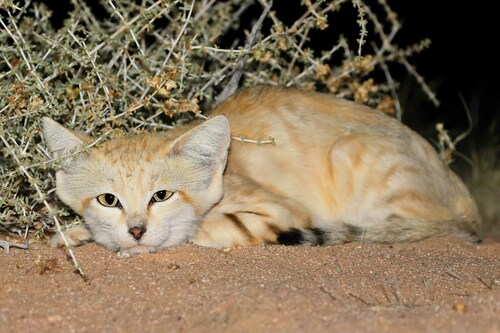
Sand Cat
Felis margarita, the elusive Sand Cat, thrives in harsh desert environments. With its camouflaged fur and heat-adapting features, it skillfully hunts at night, embodying resilience and survival. This small feline plays a crucial role in controlling rodent populations within its fragile ecosystem.
1.4969 - 3.4028 kg
Weight
Length: 38 - 51 cm; Height: 24 - 36 cm
Size
Brown, Grey, Yellow, Beige
Color
9-14 months
Age of Sexual Maturity
5 weeks
Age of Weaning
Low
Aggression
25 mph
Top Speed
Least Concern
Conservation Status
Unknown
Population Trend
Characteristics
Felis margarita, commonly known as the Sand Cat, is adapted to desert life with its sandy coat, large ears for heat dissipation, and fur-lined paws that protect against hot sand. It is nocturnal, inhabits arid regions, and preys on small rodents and reptiles.
Distribution Range of the Sand Cat
Felis margarita, commonly known as the sand cat, is native to the arid regions of North Africa, the Middle East, and Central Asia. Its geographical distribution spans across the Sahara Desert in North Africa, the Arabian Peninsula, and extends into parts of Iran, Pakistan, and Turkmenistan.
Sand Cat's Habitat
Environmental Conditions
The sand cat inhabits extreme desert environments characterized by sandy and stony terrain. These regions experience harsh climatic conditions with high temperature fluctuations between day and night, low humidity, and minimal precipitation. The sand cat is well-adapted to these arid conditions, often found in areas with sparse vegetation such as grasses, shrubs, and scattered acacia trees.
Ecological Niche
Felis margarita occupies a unique ecological niche as a nocturnal predator in the desert ecosystem. It primarily preys on small rodents, birds, and insects, utilizing its keen senses and stealth to navigate the sandy terrain. The sand cat has evolved several adaptations for desert survival, including fur-covered feet to traverse hot sand and the ability to extract moisture from its prey, minimizing its need for water.
Copyright @ Nature Style Limited. All Rights Reserved.
 English
English